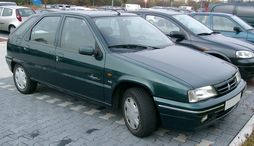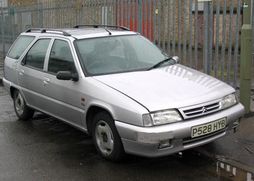The History Of Citroen ZX

The Citroën ZX is a small family car produced by the French manufacturer Citroën between 1991 and 1998.
During the 1990s, the ZX was Citroën's competitor in the class, traditionally dominated in Europe by the Ford Escort and Volkswagen Golf, a market segment Citroën had moved away from when the GSA was replaced with the BX ten years earlier. The BX had tried to address the small family car market and the large family car market by being 'between sizes' but well packaged. The Citroën ZX chassis was also used for the Peugeot 306 in 1993, which with its attractive Peugeot 205 derived Pininfarina styling, was a more successful car than its twin. The Citroën Berlingo and Peugeot Partner were also built on the same platform. European production and sales of the ZX ceased in 1998 with the arrival of the replacement Citroën Xsara.
A notchback derivative called the Citroën Elysée continued to be produced till 2008 for the Chinese market (where it is a popular taxi), by the Dongfeng Peugeot-Citroën Automobile, a joint venture with the PSA Group.
The ZX's interior space and value received praise from critics and consumers. Of particular note was the rear seat arrangement; it was mounted on a sliding platform that allowed the seat to be moved rearwards to increase rear legroom, or forwards to increase cargo space. Unfortunately, only the seat backs folded down on models so fitted. Lower specification models with fully folding and removable seats had more ultimate capacity. The ZX specification was good for its class, with most models getting power steering, electric windows, electric sunroof, a passenger's side electric mirror, a driver's side (and sometimes passenger's side) airbag and anti-lock braking system as either optional or standard equipment.
The ZX felt more solid than a BX, but was still criticised for the lack of quality feel, particularly in the interior plastics and body panels - (the thin side panels were prone to pick up supermarket car park trolly dents), and also the easily worn fabrics in low spec models, in comparison with rivals such as the Volkswagen Golf. It was competitively priced though, unlike the Golf, which was priced at a premium. Although the diesel engines were very durable (with many examples clocking up 400,000 kilometers with only routine servicing) the gasoline engines did receive some criticism for their unreliability. The ZX's styling though it had similarities to the Bertone designed XM, (especially in estate form), was also disliked by many Citroën enthusiasts, who saw it as far too conservative and bland from a company previously known for its bold and advanced design (DS, CX, BX, XM).
The familiar range of PSA powertrains drove the front wheels of a seemingly conventionally designed chassis. At the front was a standard McPherson strut layout with anti-roll bar, while the rear used a semi-independent trailing arm/ torsion bar set up. However, PSA's chassis engineers employed some unusual features, including passive rear wheel steering to control Lift-off oversteer, (by means of specially designed compliance bushes in the rear suspension), and in-house developed and constructed shock absorbers. The ZX estate models employed a unique rear suspension form, not used on other PSA cars, which is now difficult to source. The diesel and larger capacity petrol engines are canted as far back as possible in the engine bay in an effort to put as much weight as possible behind the front axle line, improving weight distribution, and minimising understeer. The ZX/ 306 was widely regarded as the best handling small family car of its time, until the arrival of the Ford Focus.
At the time of launch in 1991, the ZX range consisted of four trim levels - a basic "Reflex"; the better appointed "Avantage" and "Aura" with its power steering which added electric front windows, sun-roof and other conveniences; and the "Volcane" which provided such comforts as lumbar adjustment for the front seats, front fog-lamps, and a lowered, sporty suspension. These trims were available for the three-door, five-door and (later) estate models.
The ZX was slightly remodelled internally and externally in 1995, adding components such as a driver's airbag and keypad immobiliser and other items dependent on the above trim levels, as well as mechanical refinements such as the option of ABS on the higher models. Further models were introduced including the "Furio" (a cheaper sports model), a 16-valve-engined high performance derivative and many special editions. The very potent 16 valve type was a base for a group A rally ZX built by Cemoni Ohlsson in Sweden. The group A-tuned engine was very strong, but the chassis did not match.
The ZX was initially available as a three or five-door hatchback, while a class-leading five-door station wagon was added to the range in 1993. It was offered with 1.1L (not in UK), 1.4L, 1.6L, 1.9 L and 2.0L petrol engines, as well as two 1.9L diesel engines including a highly rated turbodiesel, which was one of the best diesel engines in its class when compared with lumbering older Vauxhall and Ford diesels. Although the 1.9L and 2.0L gasoline engines gave strong performance matched to a finely tuned chassis to give good handling, the real star of the range was always the intercooled XUD9 turbo-diesel. This otherwise very rugged engine needs its cooling system to be well maintained, if it isn't, it has a tendency to blow head gaskets. This isn't helped by the fact that the radiators consistently fail at about 100,000miles (160,000km). The Indirect Injection XUD Diesel is popular for conversion to run on heated, (and so thinned) vegetable oil, particularly when using the Bosch VE injection pump.
- 1.4L (1360cc) TU3 I4, 75PS (74hp/ 55kW), 89ft·lbf (121N·m)
- 1.6L (1580cc) XU5 I4, 90PS (88hp/ 66kW), 99ft·lbf (135N·m)
- 1.8L (1761cc) XU7 I4, 103PS (101hp/ 75kW), 113ft·lbf (153N·m)
- 1.8L (1761cc) XU7 I4, 112PS (110hp/ 82kW), 114ft·lbf (155N·m)
- 1.9L (1905cc) XUD9 diesel I4, 65PS (64hp/ 47kW), 88ft·lbf (120N·m)
- 1.9L (1905cc) XUD9 diesel I4, 90PS (88hp/ 66kW), 144ft·lbf (196N·m)
- 1.9L (1905cc) XU9 I4, 122PS (120hp/ 89kW), 110ft·lbf (150N·m)
- 2.0L (1998cc) XU10 I4, 123PS (121hp/ 90kW), 129ft·lbf (176N·m)
- 2.0L (1998cc) XU10 I4, 150PS (147hp/ 110kW), 135ft·lbf (183N·m)
- 2.0 L (1998 cc) XU10 J4TE I4, turbo, 167 PS (197 hp/ 147 kW).
From Wikipedia, the free encyclopedia
More About Citroen ZX


|